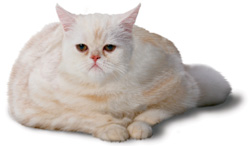Fat Cats and Pudgy Pooches
We people aren’t the only ones fighting the battle of the bulge. Veterinary nutritionist Andrea Fascetti, an associate professor in the School of Veterinary Medicine, notes that studies have shown that 25–50 percent of cats and dogs in the United States are overweight or obese. It’s an important issue because overweight pets have a higher risk of developing ailments like diabetes mellitus, arthritis and breathing problems. Fascetti notes that a recent study of Labrador retrievers showed that dogs that were carefully fed to maintain ideal body condition lived up to two years longer than did dogs whose food intake was not restricted. Fascetti shares a few tummy-trimming tips below and notes that the teaching hospital’s Nutrition Support Service is happy to consult with primary-care veterinarians. Pet owners seeking an appointment at the Veterinary Medical Teaching Hospital for weight-management or any other nutritional concerns can contact the hospital at (530) 752-1393.
Q: What’s the best way to prevent a kitten or puppy from becoming obese later in life?
A: When you take your new family member in for its first visit to the veterinarian, make sure to discuss appropriate feeding practices, diet selection and exercise. Ask for guidance on how much to feed your pet and how to monitor its body condition. You’ll want to be able to quickly recognize if your animal starts to become overweight so that you can adjust its feeding. You should especially watch for an increase in food intake after the animal is neutered.
Q: How can I tell if my dog or cat is overweight?
A: During routine checkups, ask your veterinarian to show you how to evaluate your pet’s body condition and determine if it is overweight. If you suspect the animal is becoming overweight, schedule a special appointment with your vet to discuss a feeding program that will produce a safe and healthy rate of weight loss in your pet. Weight-loss plans are designed to achieve steady weight loss while keeping the animal as comfortable as possible. It’s generally recommended that pets lose no more than 2 percent of their body weight per week. Any faster weight loss may cause the animal to feel and act hungrier, and slow the pet’s metabolism.
Q: Are veterinarians seeing weight problems in other companion animals, like hamsters, rabbits, snakes, etc?
A: The problem of obesity is not limited to only dogs and cats. We are seeing an increased number of other pets, including horses, rabbits and other small mammals, with this problem.
Q: If my pet is on a restricted diet can I still give it treats? And what about table scraps?
A: Treats are an important part of every pet’s diet; they strengthen the human-animal bond and provide the animal with feedback that it is a significant member of the family. Treats should be limited, however, to no more than 10 percent of a pet’s daily caloric intake to avoid creating a nutrient deficiency, since most treats are not complete, balanced foods. You would be surprised how many calories some treats contain. Try to avoid table scraps, which are often full of fat, gristle and boney pieces. However, some people foods can be used as pet treats. Check with your veterinarian on which treats are acceptable because dogs and cats cannot safely consume all of the same foods that people can.
Q: What type of exercise is appropriate for dogs and what type for cats?
A: Playing or walking with your pets is a great way to increase their sense of appreciation and helps to manage their weight by burning fat and increasing muscle mass. Plus, it gives you a fun opportunity to burn a few calories yourself. Just as you would consult your physician before embarking on an exercise program, so should you speak to your vet about an appropriate level of exercise for your pets. Many animals that need to lose weight have other medical conditions that should be considered when planning an exercise program.
Q: Once my dog or cat has reached the appropriate weight, how can I make sure it doesn’t regain the weight it lost?
A: Once your pet has achieved its weight-loss goals, you’ll need to work closely with your veterinarian to determine what and how much to feed it. Your veterinarian may have chosen a special food for weight loss and, after the animal has achieved the goal, will return it to a standard maintenance diet. It then will be important to control how much your pet eats and find the amount of food that will maintain a healthy body weight. This may take several trips back to the veterinarian for periodic weight checks, but be patient—in time you’ll find just the right amount of food that will result in a healthier, happier pet.

|

